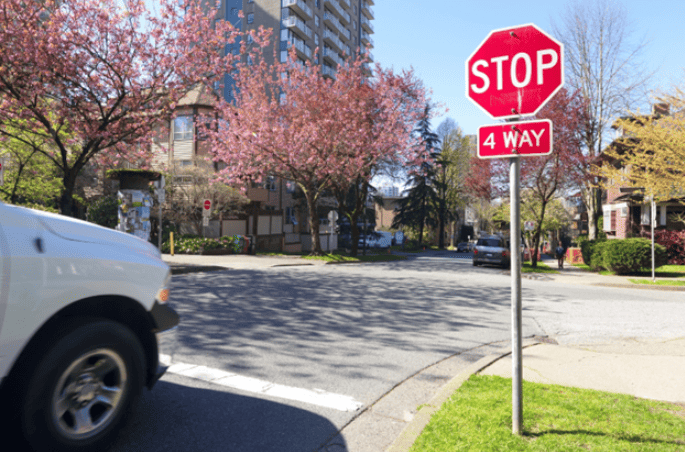- Need Any Help: +1 647-760-5505 or
- info@trubicars.ca
One of the most troubling things for new drivers to master is making proper right and left turns. When learning to drive, we do so many turns that if done smoothly, we can remain safe on the roads and pass the driving test. Using a top-quality driving school found through Trubicars can help to build positive habits.
Getting into poor habits can put you and your vehicle at risk of getting into a collision or even receiving a ticket. Also, poor turning habits can affect your results if you are going for a driving test. Finding a driving school through Trubicars can help you get the basics of turning. So, let’s break down the steps required to make a perfect right and left turn every time.
Let’s begin with the steps for making a right turn. As you approach the intersection, signal your turn roughly half a block from the corner. Signaling at this time will give the driver behind you enough notice to adjust their vehicle to you before you begin the turn. Immediately after signaling, make a glance in the rear-view mirror. If you notice the driver behind is very close to you, start braking earlier than you would normally do, but do so more gradually. This will allow the driver behind you to brake early and smoothly as you make the turn.
Now that your turn signal is on, move your vehicle within one metre of the curb. Your goal is to keep as much of that one metre from the curb all the way around the corner. Once your vehicle is one metre from the curb, begin braking smoothly and look well ahead as you approach the intersection.

Looking well ahead will help you to keep your vehicle parallel to the curb or edge of the road as you approach the corner. These first few steps should be completed when your vehicle is approximately five car lengths from the intersection. The remaining distance from the corner will give you enough time to complete the other steps to complete the turn smoothly.
Because you want your vehicle to remain one metre from the curb all the way around the corner, you should begin turning the steering wheel when the front of the vehicle has reached the point where the curb/edge of the road has started to curve. As you approach that position, glance at the curb and begin steering smoothly and consistently as you follow along the curb with your eyes.
Once you feel you have gone approximately halfway around the corner, look up the road and begin to recover the steering. After the turn, apply pressure on the accelerator to get up to speed. Be sure to have another glance in your rear-view mirror to help keep you up to date with any vehicle that may have followed you around the corner.
To make these steps a driving habit, continually drive around the block one right turn after right turn. Keep the steps in the same order so you can build muscle memory. The only step in which you could change would be braking. It is typically the fourth step, but if you are moving quickly, you may need to brake sooner so your vehicle is at a slow speed in time to complete the remaining steps.
Let’s build your skills for making a smooth left turn. Many of the steps for a left turn are similar to making a right turn, but not all. Let’s break down the steps for you.
Just as the right turn, you want to signal for the left turn approximately half a block from the intersection. This will allow the driver behind to adjust their speed or even change lanes to avoid being slowed down by your turn. After the signal, check the rear-view mirror to determine if you need to brake sooner if you are being followed too closely.
You now want to position your vehicle close to the centre of the road, whether there’s a yellow line down the centre or not. This position will help let other road users that you will be turning left. If no yellow line is available down the road, make an educated guess as to where the centre of the road is. If a stop sign is ahead and a stop line is on the road, the centre of the road is typically where the stop line ends.
Once you’ve positioned your vehicle close to the centre of the road, look ahead to help keep your vehicle parallel to the curb and begin braking. If there is a stop, stop before starting any steering. The first few turn steps should be completed approximately four car lengths from the intersection. This will give you enough time to complete the remaining steps for the left turn.
You now want to begin steering once the front of your vehicle has reached the edge of the road. The problem with turning earlier than the edge of the road is that you would end up cutting the corner and ending up on the wrong side while making the turn.
Once the front of your vehicle has reached the edge of the road, look to the centre of the road you’re turning toward and begin steering smoothly. If a yellow line is on the road you just entered, continue to look up that line as you begin turning. If there is no yellow line on the road, make a judgment call as to where the centre of the new road would be.
Once your vehicle is approximately halfway around the corner, look ahead and start to recover the steering as smoothly and consistently as you did while making the turn. After the left turn, you can begin to apply pressure to the accelerator gently. It would also be a good time to glance in your rear-view mirror to help you keep up to date with any vehicle that may have followed you around the corner.
Following these steps regularly will help to make them into a habit and will not only help you pass your driving test, but it will also help to keep your vehicle safely in your lane.
Learning how to make smooth and consistent turns comes directly from a professional driving instructor. Contact Trubicars now to find the driving school and instructor close to you and sign up with a driving school today!
Ontario Driver’s License Classes

 January 3, 2025 by
January 3, 2025 by Trubicars
Trubicars
 February 13, 2024 by
February 13, 2024 by Reema Sharma
Reema Sharma
 January 17, 2024 by
January 17, 2024 by Trubicars
Trubicars
Once you acquire the knowledge provided in
those tests, you are ready to pass the test,
for the first time.
